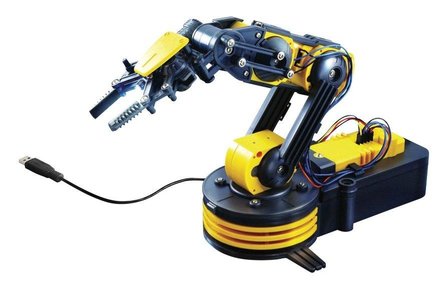paplin v1.0.4
Paplin.js
A promise based Node JS package for controlling the Maplin Robot Arm.
If you're looking for a programme to control the arm with your keyboard then check out Maplin Robot Arm Controller.

Contents
- Installation
- Connecting to the Arm
- Controlling the Arm
- A Full Example
- Running your programme
- Notes About Movement Accuracy
Installation
npm install --save paplinconst Paplin = require('paplin');
const Arm = new Paplin();Connecting to the Arm
Plug the arm into a usb port and make sure it's turned on. To open a connection call the Arm.openConnection(vendorId) method and pass the device's vendor id.
const vendorId = 4711;
const connected = Arm.openConnection(vendorId);
if (connected) {
// Do stuff...
}Closing the Connection
Arm.closeConnection();Controlling the Arm
Once a connection has been opened you can control the arm by calling methods on the Arm instance.
Making Movements
The arm is moved by calling move methods on the Arm instance. Each move method accepts a time parameter that defines, in milliseconds, how long the move will me made for.
Arm.moveShoulderUp(300);Each move method returns a Promise. Using promises commands can be chained together to form long sequences of moves.
Arm.moveShoulderUp(300).then(Arm => {
Arm.moveShoulderCounterclockwise(1000).then(Arm => {
Arm.openGrip(100).then(Arm => {
// etc
});
});
});The following move methods are available:
// Shoulder (base)
Arm.moveShoulderUp(time);
Arm.moveShoulderDown(time);
Arm.moveShoulderClockwise(time);
Arm.moveShoulderCounterclockwise(time);
// Elbow
Arm.moveElbowUp(time);
Arm.moveElbowDown(time);
// Wrist
Arm.moveWristUp(time);
Arm.moveWristDown(time);
// Grip
Arm.openGrip(time);
Arm.closeGrip(time);Making Moves Concurrently
As well as creating sequences of moves, multiple moves can be made simultaneously using the Arm.concurrent() method. The concurrent method accepts a callback, which is passed an instance of ConcurrentMoveSequencer. The moves that you want to be made concurrently are defined by calling move methods on the ConcurrentMoveSequencer instance.
Arm.concurrent(Concurrent => {
Concurrent.moveShoulderClockwise(2000);
Concurrent.moveShoulderDown(1000);
Concurrent.closeGrip(500);
});The ConcurrentMoveSequencer has the same move methods available as the Arm. Each method accepts a time, in milliseconds, to make the move for. Unlink the Arm move methods, however, these methods do not return promises so can't be chained together.
The Arm.concurrent() method returns a Promise, which can be used to chain commands together.
Arm.concurrent(Concurrent => {
Concurrent.moveShoulderClockwise(2000);
Concurrent.moveShoulderDown(1000);
Concurrent.closeGrip(500);
}).then(Arm => {
Arm.moveElbowDown(1000).then(Arm => {
// etc
});
});Stopping Movements
Movements will automatically stop after the given time has elapsed, however they can be stopped prematurely with the following methods.
.stopMovement()
Stops all movements but keeps the light on, if it's on.
Arm.turnLightOn().then(Arm => {
Arm.moveShoulderUp(1000).then(() => {
// etc
});
});
setTimeout(() => Arm.stopMovement(), 300);.stop()
Stops all movements and turns the light off.
Arm.turnLightOn().then(Arm => {
Arm.moveShoulderUp(1000).then(() => {
// etc
});
});
setTimeout(() => Arm.stop(), 300);Controlling the Light
Arm.turnLightOn();
Arm.turnLightOff();Both of these methods return a Promise, which can be used to chain commands together.
Arm.turnLightOn().then(Arm => {
Arm.moveShoulderUp(300).then(Arm => {
// etc
});
});A Full Example
const Paplin = require('paplin');
const Arm = new Paplin();
const vendorId = 4711;
const connected = Arm.openConnection(vendorId);
if (connected) {
Arm.turnLightOn().then(Arm => {
Arm.moveShoulderCounterclockwise(1000).then(Arm => {
Arm.concurrent(Concurrent => {
Concurrent.moveWristDown(500);
Concurrent.moveElbowDown(1000);
Concurrent.closeGrip(1000);
}).then(Arm => {
Arm.turnLightOff().then(Arm => {
Arm.closeConnection();
});
});
});
});
}Running your programme
To execute your code and move the arm run:
node path/to/file.jsNotes About Movement Accuracy
All of the movement commands are time based, i.e., the arm moves for a given number of milliseconds before stopping. It's worth noting that although two moves can be performed for the same amount of time, the distance traveled won't necessarily be the same. For example moving the shoulder down for 1s and then up for 1s will not necessarily return the arm to the same place. The reason for this is that the speed at which the arm moves is not consistent. If the arm is moving down then it will tend to move faster as it will be assisted by gravity, and when moving up it will be going against gravity so will move slower.